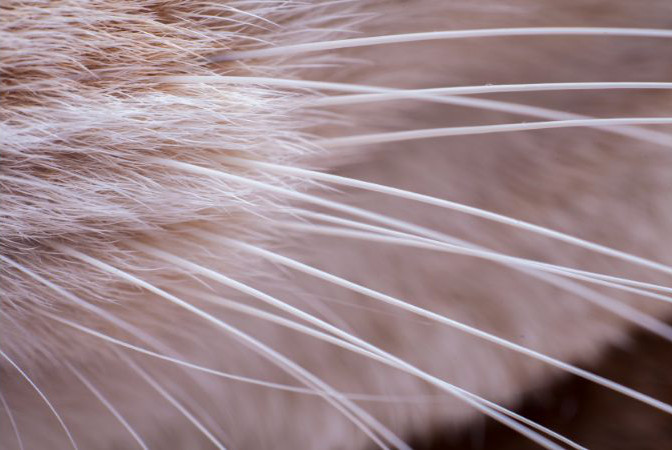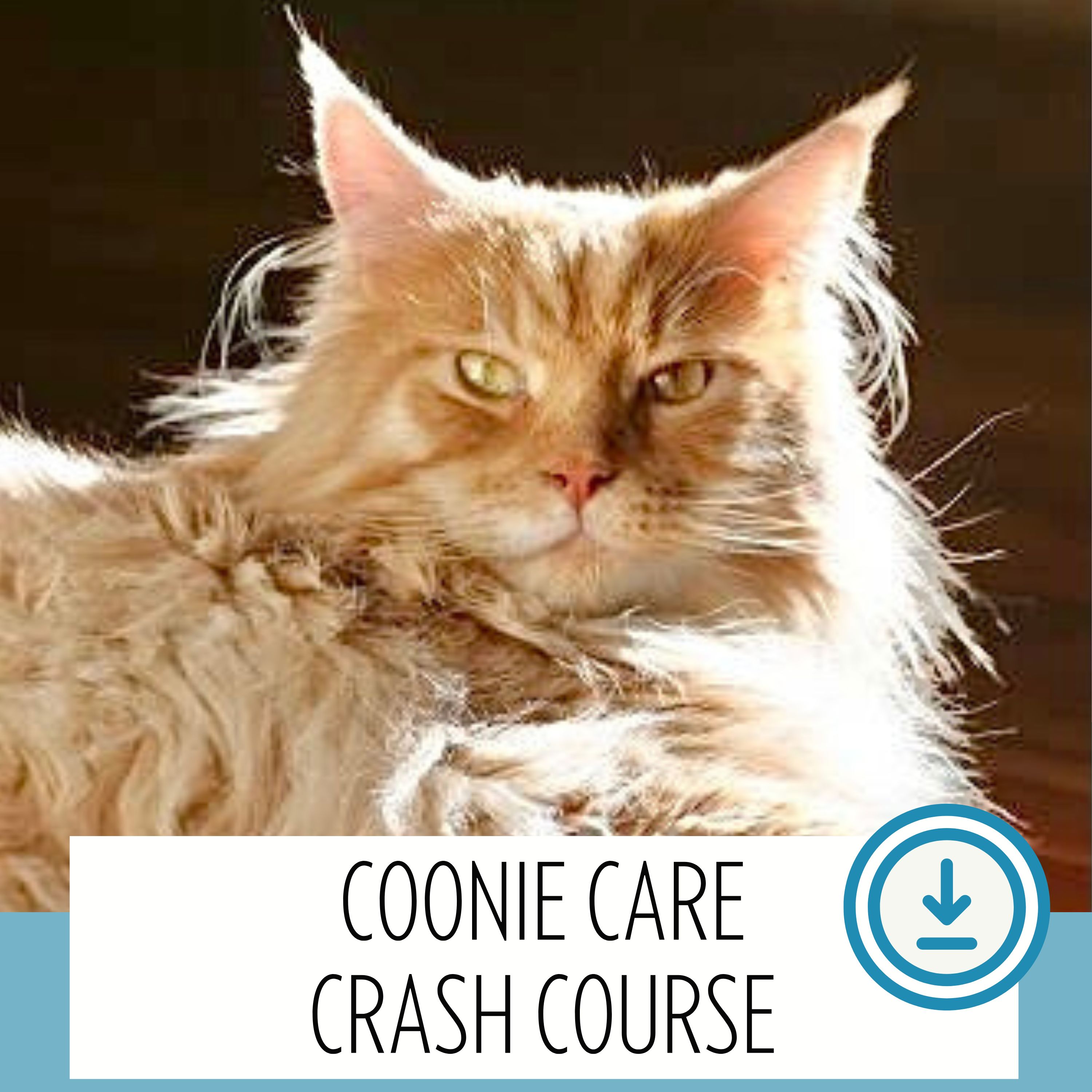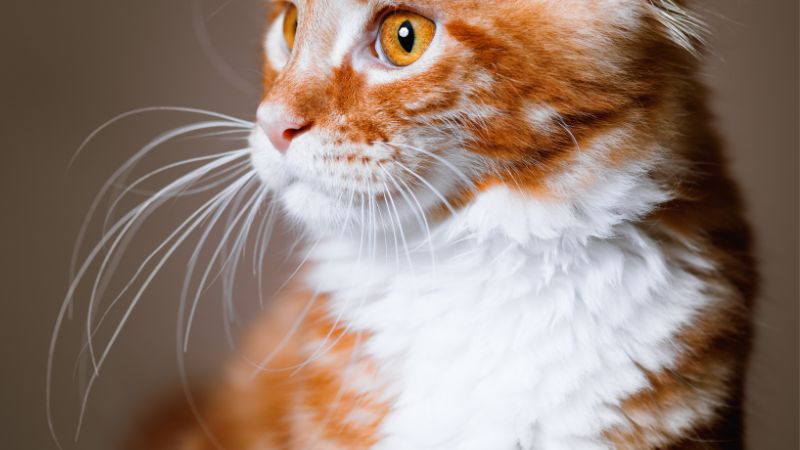- Home
- About Maine Coon Cats
- Maine Coon Whiskers
Maine Coon Whiskers
40 Amazing, Fascinating Facts!
Maine Coon whiskers are a distinctive feature! Between important facts and, caring for them, the purpose they serve, myths and more, there is actually a lot to know about them!
Maine Coon whiskers, or vibrissae, are fascinating structures with unique characteristics and functions. Here are some interesting facts and statistics about this remarkable feature:
1. Highly Sensitive: Cat whiskers are extremely sensitive, with each one containing a rich supply of nerve endings that connect to the nervous system, allowing felines to detect the slightest changes in their environment.
2. Proprioception: They play a crucial role in proprioception, which is a cat's ability to sense its body position and movements. This helps them navigate through narrow spaces and judge distances accurately.

3. Multipurpose Tools:
Cats
have vibrissae not only on their faces but also above their eyes
(superciliary whiskers), on their chins (mandibular whiskers), and
on the backs of their front legs (carpal whiskers). Each set of serves a different sensory function.
4. Night Vision Aids: While felines have excellent night vision, these facial hairs enhance their ability to move around in the dark by detecting objects and changes in their surroundings through air currents.
5. Whisker Fatigue: Cats can experience whisker fatigue, a condition where overstimulation from constant contact with objects (such as narrow food bowls) leads to discomfort and stress. Using shallow, wide dishes can help prevent this.
6. Growth and Replacement: If a whisker falls out, a new one will grow in its place. The growth cycle ensures there are always functional whiskers for sensory input.
7. Tactile Communication: The position and movement of vibrissae can communicate a cat’s emotional state.
Facial hairs in a forward position often indicate curiosity or interest, while whiskers pulled back against the cat's face may signal fear or aggression.
8. Length Proportionality: The length of the whiskers is generally about the width of its body, allowing kitty to gauge whether it can fit through tight spaces.
9. Individual Variation: Each animal’s vibrissae are unique in length, thickness, and even the number. While most felines have about 24, some may have more or fewer.
10. Mystacial Pads: The areas of the face where they are rooted, called mystacial pads, are highly innervated and play a significant role in the sensory perception of whiskers. Feline whiskers are technically called mystacial whiskers.
11. Evolutionary Advantage: This feature has evolved as an essential adaptation for hunting and survival. They help to detect prey and navigate through complex environments, especially in low-light conditions.
12. Radar for Close-Up Vision: Cats are far-sighted and have difficulty seeing objects up close. Whiskers act like a radar system, helping them detect and analyze objects that are too close for their eyes to focus on properly.

Maine Coon Whiskers:
Our gentle giants are known for their distinctive appearance and impressive size. Their vibrissae are no exception!
Here are some more interesting facts and statistics - these are about Maine
Coon whiskers in particular:
13. Record Breakers: Maine Coons often have the most impressive whiskers among all cat breeds. On average, they can grow to be around 6 inches (15 cm) long, with some even exceeding this length.
The Guinness World Record for the longest whiskers on a cat is held by a Maine Coon named Missi, whose vibrissae measured 7.5 inches (19 cm). What a unique feature!
14. Proportional to Size: As one of the largest domestic cat breeds, the length of Maine Coon whiskers is proportionate to their body size.
Their substantial facial bristles help them navigate their environment effectively despite their large frames.
15. Thick and Robust: The Maine Coon whiskers are typically thicker and more robust compared to those of a typical cat.
This characteristic enhances their tactile sensitivity, and may have helped early Coonies in their hunting activities.
16. Facial Framing: The prominent and long whiskers of Maine Coons contribute to their distinctive facial features, framing their broad, expressive faces and enhancing their majestic appearance.
17. Highly Functional: Given the Maine Coon's natural evolution and outdoor adaptability, their vibrissae play an essential role in detecting prey, navigating through various terrains, and sensing environmental changes, especially in low-light conditions.
18. Indicator of Health and Mood: Like other felines, the position and condition of Maine Coon whiskers can provide insights into their health and mood.
Healthy whisker hairs are a sign of good nutrition and overall well-being, while damaged or missing ones may indicate stress or health issues.
19. Breed-Specific Care: Due to their length and thickness, Maine Coon whiskers are a noticable feature.
Owners should avoid cutting or trimming these long hairs, as doing so can impair the cat's ability to navigate and sense its surroundings effectively.
Even if your Maine Coon is indoors only, losing them would cause stress.
20. Whisker Fatigue Consideration: While whisker fatigue can affect any cat, the extra length of Maine Coon whiskers may make them more susceptible to this condition.
Owners may need to provide wide and shallow food and water bowls to minimize whisker stress.
These unique attributes make Maine Coon whiskers not only an essential sensory tool but also a defining feature of this beloved breed.

21. How Whiskers Fall Out
Vibrissae, like other types of hair, naturally fall out and grow back over time. Here are the details on how, when, and why a cat’s whisker might fall out:
Natural Shedding:
They can fall out as part of the cat’s normal hair growth cycle. Each one goes through a growth phase, a resting phase, and a shedding phase.
Mechanical Damage:
Whiskers can break or fall out due to physical trauma. Rough play, fights with other animals, or getting caught in objects can cause them to break or fall out.
Health Issues:
Certain medical conditions, such as skin infections, allergies, or mites, can lead to whisker loss. Nutritional deficiencies or hormonal imbalances might also affect whisker health.
22. When Whiskers Fall Out
Periodic Shedding:
Cats do shed them periodically, but not all at once. Typically, you might notice one or two falling out occasionally, similar to how cats shed fur.
Seasonal Changes:
Some cats experience more whisker shedding during certain seasons, much like their fur, which might shed more in response to changing temperatures.
23. Why Whiskers Fall Out
Natural Renewal:
Just like fur and other body hair, they have a life cycle and naturally fall out when they are old, making way for new ones to grow.
Environmental Adaptation:
Shedding them can help cats adapt to changes in their environment.
New whisker hairs might grow in more suited to the current conditions or after the cat experiences changes in its surroundings.
Health Indicators:
Sometimes they fall out due to underlying health issues. Infections, dermatitis, or systemic diseases might cause whisker loss. This can be an indicator for pet owners to consult a veterinarian.
24. What to Do If You Notice Whisker Loss
Monitor the Frequency:
If you notice a whisker falling out occasionally, it’s usually normal. However, if you observe excessive loss, it might be worth investigating further.
Check for Other Symptoms:
Look for signs of skin issues, behavioral changes, or other symptoms that might indicate a health problem.
Consult a Veterinarian:
If you are concerned about your cat’s whisker loss or if it is accompanied by other signs of illness, it’s best to consult a vet.
They can perform a thorough examination to determine if there’s an underlying health issue.
Occasional whisker loss is a
normal part of a cat’s life, but significant or sudden changes in
whisker health should be monitored and addressed appropriately.

25. Do a Cat's Whiskers' Color Match Their Coat?
They can vary in color, and they sometimes match the color of the cat’s coat, but this is not a strict rule. Here are some details about whisker color:
Color Matching:
In many cats, whiskers are white regardless of their coat color. This is common in both solid-colored cats and those with patterns.
Some cats may have whisker hairs that match their fur, especially if they have darker or mixed coat colors.
For example, black or dark-colored cats might have black whiskers, and cats with mixed colors might have ones that are partly colored.
Individual Variation:
Whisker color can vary greatly between individual cats, even within the same breed. It's influenced by genetics and sometimes changes with age.
26. Maine Coon Breed Standard Considerations Regarding Whisker Color
When it comes to the breed standards for Maine Coon cats, whisker color is generally not a specific consideration.
The main focus of breed standards tends to be on aspects like body structure, coat length and texture, ear shape, eye color, and overall size. Here are the key points:
Breed Standards:
Organizations like the Cat Fanciers’ Association (CFA) and The International Cat Association (TICA) provide breed standards for Maine Coons, but they do not specify whisker color as a criterion.
The emphasis is usually on the cat's overall physical appearance, health, and temperament.
Acceptable Variations:
Maine Coons are known for their large size, tufted ears, bushy tails, and friendly nature.
Their vibrissae are expected to be long and sturdy, aligning with their robust build. Color variations in whisker hairs are considered normal and acceptable within the breed.
There are no disqualifications based on whisker color in major cat shows and competitions.
Focus on Overall Quality:
Judges and breeders focus on the overall quality and adherence to breed standards rather than specific traits like whisker color.
The health, grooming, and presentation of the cat are of higher importance.

While
a cat's whisker color can sometimes match their coat, it is not a
strict rule and can vary among individuals.
In the case of Maine Coons, breed standards do not include specific requirements for whisker color.
The primary focus is on overall appearance, health,
and adherence to other breed characteristics.

27. "Do Cats Mind if Their Whiskers Are Touched or Played With?"
Most cats generally do not like having them touched or played with. Here are several reasons why:
Whisker Sensitivity
Highly Sensitive Nerve Endings: Whisker hairs are deeply embedded in the cat's skin and connected to a high concentration of nerve endings, making them extremely sensitive.
Touching or playing with them can cause discomfort or irritation.
Sensory Overload: Because they are important sensory tools, unnecessary handling can lead to sensory overload.
This can be stressful for and make them feel uneasy or threatened.
Behavioral Responses
Avoidance and Irritation: Even a very gentle cat may pull away, twitch, or even swat at someone who touches their whisker hairs.
This is a natural response to avoid the discomfort caused by the tactile sensitivity.
Stress and Anxiety: Persistent touching can lead to stress and anxiety.
Felines rely on them for spatial awareness and navigation, and interference with them can cause a sense of disorientation or vulnerability.
Exceptions and Individual Differences
While most pets are sensitive about them, individual tolerance levels can vary.
Some Maine Coons might tolerate gentle touches if they trust the person and are in a calm state, but this is less common.
In some cases, Maine Coons might become accustomed to light touches around this area if it is associated with positive experiences, such as petting or grooming in areas they enjoy.
Proper Interaction with Cats
Especially for children, it can be tempting to play with Maine Coon whiskers, since they are so long and magnificent! Here are some alternatives and things to keep in mind:
It's essential to respect a cat's boundaries and avoid touching their facial hairs.
Pay attention to their body language and reactions to
understand what they are comfortable with.
Focus on petting areas that most kitties enjoy, such as the top of the head, behind the ears, under the chin, and along the back.
These areas are typically less sensitive and more enjoyable.
Engage in positive interactions that do not involve sensitive areas. Use toys for play, provide treats, and offer gentle petting to build a trusting and happy relationship.
Cats generally do not like having them touched or played with due to the high sensitivity of these tactile hairs.
Handling them can cause discomfort, stress, and anxiety. Maine Coon kittens may not have as much patience.
It's important to respect boundaries and focus on interactions that they find enjoyable and comforting.

People often have a variety of questions about vibrissae due to their unique characteristics and functions. Here are some common questions:
Frequently Asked Questions (FAQ's):
28. What are cat whiskers made of?
28. What are cat whiskers made of?
They are made of keratin, the same protein that makes up human hair and nails.
29. Why do cats have whiskers?
29. Why do cats have whiskers?
They help cats navigate their environment, detect changes in their surroundings, and measure the width of openings.
30. How do whiskers work?
30. How do whiskers work?
They are highly sensitive touch receptors that can detect even slight changes in air currents, helping cats sense nearby objects and movements.
31. Do whiskers grow back if they fall out or are cut?
31. Do whiskers grow back if they fall out or are cut?
Yes, they do grow back if they fall out naturally or are trimmed, though it's important not to cut them as they are essential sensory tools for cats.
32. Can whiskers indicate a cat’s mood?
32. Can whiskers indicate a cat’s mood?
Yes, the position of a cat's whisker hairs can indicate their mood. For example, whiskers pushed forward can indicate curiosity or alertness, while whiskers pulled back may suggest fear or aggression.
33. How many whiskers do cats have?
33. How many whiskers do cats have?
Most cats have 24 whiskers, with 12 on each side of their face, though the number can vary slightly.
34. Do all cats have the same type of whiskers?
34. Do all cats have the same type of whiskers?
While all cats have whisker hairs, the length and thickness can vary depending on the breed and individual cat.
35. Why do cats have whiskers on their legs?
35. Why do cats have whiskers on their legs?
This tuft of hairs is known as carpal whiskers, and they help detect prey and navigate their surroundings more effectively.
36. What happens if a cat loses its whiskers?
36. What happens if a cat loses its whiskers?
Felines can become disoriented and have difficulty judging distances and navigating their environment without them.
37. Do whiskers have nerve endings?
37. Do whiskers have nerve endings?
The base of each whisker is packed with nerve endings, making them highly sensitive to touch and vibrations.
38. Why are some cats’ whiskers longer than others?
38. Why are some cats’ whiskers longer than others?
The length of a cat’s whiskers is generally proportional to the width of their body, helping them determine if they can fit through tight spaces.
39. Can whiskers help cats in the dark?
39. Can whiskers help cats in the dark?
Yes, they can help cats navigate in the dark by sensing air currents and nearby objects, allowing them to move around safely without relying on vision.
 Mystacial Pads
Mystacial Pads40. Myths About Feline Whiskers and Luck
There are several myths and superstitions around luck. Here are a few:
Good Luck Charms:
Some cultures believe that finding a cat whisker is a sign of good luck.
People might keep them as lucky charms, thinking they bring good fortune or protection.
Magic and Healing Properties:
In certain folklore, they are thought to have magical or healing properties.
They might be used in various rituals or as ingredients in potions intended to bring luck, health, or protection.
Protection from Evil:
Some myths suggest that whisker hairs can protect against evil spirits or bad luck.
Carrying one or placing it in a special location might be believed to ward off negative energies.
Love and Relationships:
There are myths that using a cat whisker in a love spell can attract a partner or enhance a romantic relationship.
The whisker is seen as a potent symbol of
attraction and connection.
Maine Coon Whiskers are Important:
Who knew there was so much to say about Maine Coon whiskers! All in all, keep in mind:
Natural Shedding:
Felines naturally shed their vibrissae as part of their normal hair growth cycle.
Finding a whisker is a regular occurrence for pet owners and not necessarily a sign of concern – or of luck or misfortune.
Sensitivity and Importance:
Maine Coon whiskers are important sensory tools, helping them navigate their environment and sense changes. It’s crucial to respect their natural function.
Ethical Considerations:
Cutting or forcibly removing a cat's whiskers is harmful and unethical.
It can cause pain, stress, and disorientation for the cat. Any use of them should be limited to those naturally shed by the cat.

Maine Coon whiskers play a natural and important role in their well-being.
They are essential sensory tools, highly sensitive, and a 'key ingredient' for a fulfilling life!
« Back to Maine Coon Cats Exposed
Recent Articles
-
Today's Features
Apr 16, 25 09:54 PM
Today we have two classic Memory Lane pages to share!
Murphy & Candy Cane: Double the Maine Coon Charm - This adorable Maine Coon duo from our 2011 Photo Albums - Murphy and Candy Cane - brought doubl… -
Memory Lane Month Begins!
Apr 15, 25 10:22 PM
We're thrilled to start our "Memory Lane Month" event by visiting some cherished moments from our community! We're in the process of restoring meaningful community stories like this one, to preserve t… -
Will a Maine Coon Protect Its Owner From Danger or an Intruder?
Apr 09, 25 10:41 PM
Plenty of people are curious: Will a Maine Coon protect its owner if something happens? Let’s talk about what this means, and what kind of protector a Coonie is.



